SUZUKI AERIO 2007 1.G Owners Manual
Manufacturer: SUZUKI, Model Year: 2007, Model line: AERIO, Model: SUZUKI AERIO 2007 1.GPages: 232, PDF Size: 3.34 MB
Page 91 of 232
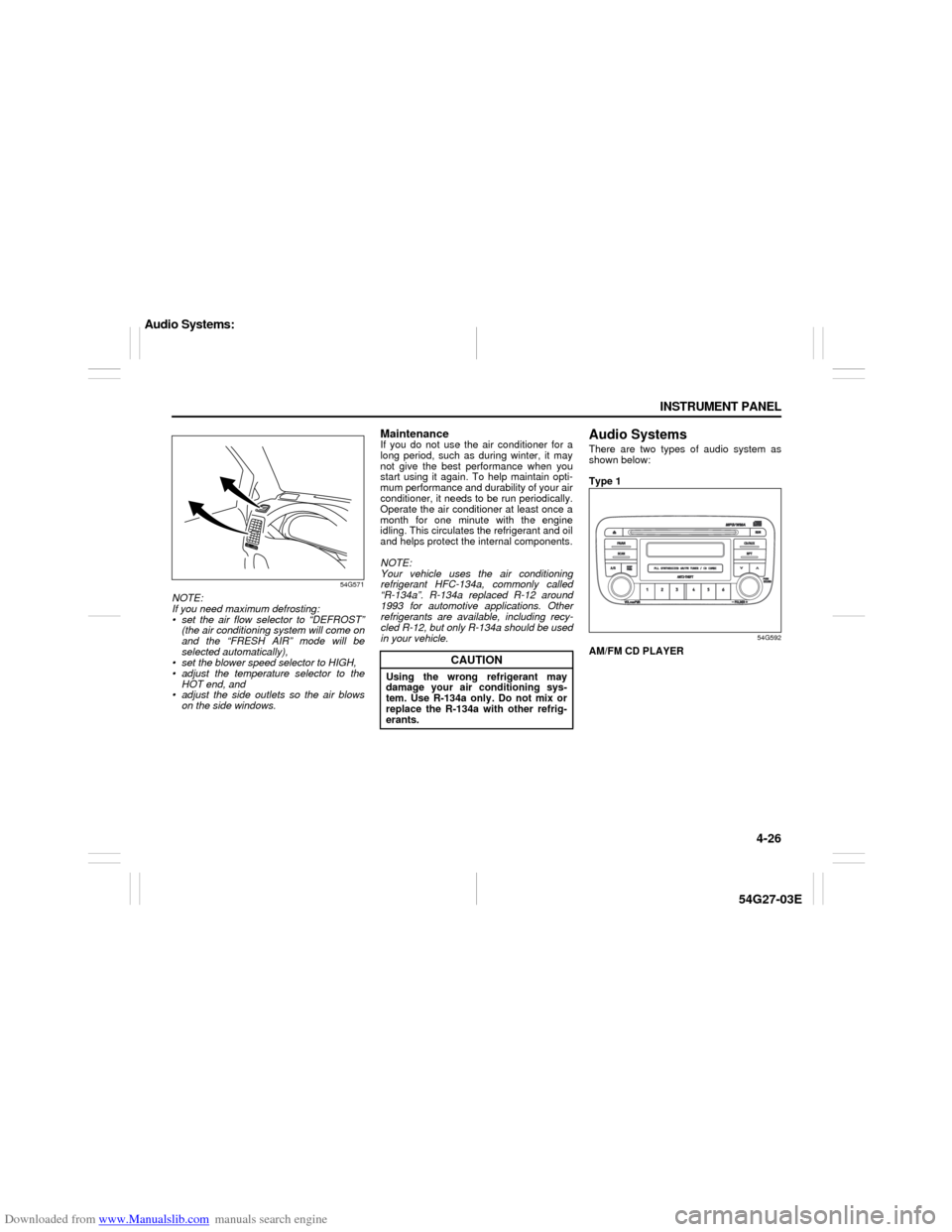
Downloaded from www.Manualslib.com manuals search engine 4-26 INSTRUMENT PANEL
54G27-03E
54G571
NOTE:
If you need maximum defrosting:
set the air flow selector to “DEFROST”
(the air conditioning system will come on
and the “FRESH AIR” mode will be
selected automatically),
set the blower speed selector to HIGH,
adjust the temperature selector to the
HOT end, and
adjust the side outlets so the air blows
on the side windows.
MaintenanceIf you do not use the air conditioner for a
long period, such as during winter, it may
not give the best performance when you
start using it again. To help maintain opti-
mum performance and durability of your air
conditioner, it needs to be run periodically.
Operate the air conditioner at least once a
month for one minute with the engine
idling. This circulates the refrigerant and oil
and helps protect the internal components.
NOTE:
Your vehicle uses the air conditioning
refrigerant HFC-134a, commonly called
“R-134a”. R-134a replaced R-12 around
1993 for automotive applications. Other
refrigerants are available, including recy-
cled R-12, but only R-134a should be used
in your vehicle.
Audio SystemsThere are two types of audio system as
shown below:
Type 1
54G592
AM/FM CD PLAYER
CAUTION
Using the wrong refrigerant may
damage your air conditioning sys-
tem. Use R-134a only. Do not mix or
replace the R-134a with other refrig-
erants.
Audio Systems:
Page 92 of 232
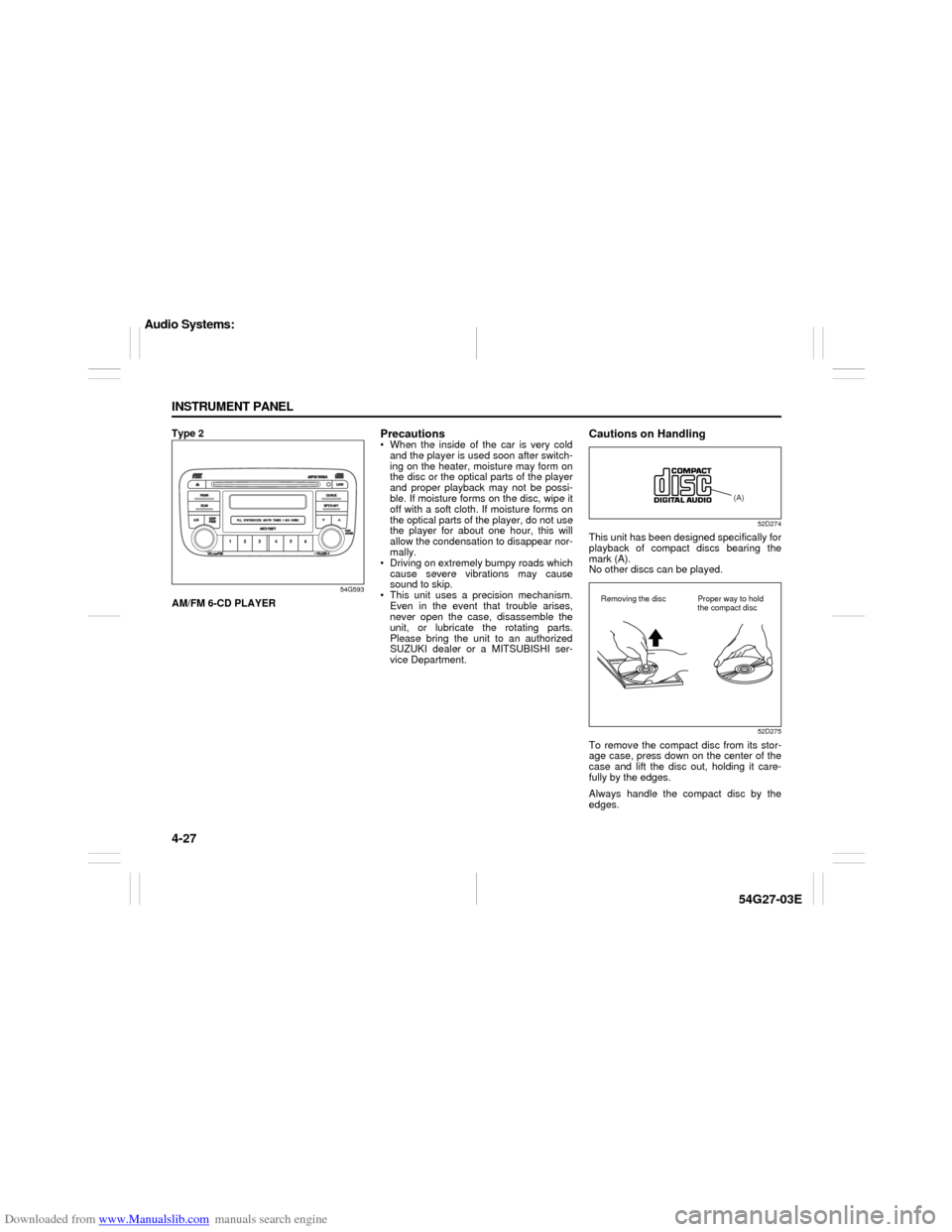
Downloaded from www.Manualslib.com manuals search engine 4-27 INSTRUMENT PANEL
54G27-03E
Type 2
54G593
AM/FM 6-CD PLAYER
Precautions When the inside of the car is very cold
and the player is used soon after switch-
ing on the heater, moisture may form on
the disc or the optical parts of the player
and proper playback may not be possi-
ble. If moisture forms on the disc, wipe it
off with a soft cloth. If moisture forms on
the optical parts of the player, do not use
the player for about one hour, this will
allow the condensation to disappear nor-
mally.
Driving on extremely bumpy roads which
cause severe vibrations may cause
sound to skip.
This unit uses a precision mechanism.
Even in the event that trouble arises,
never open the case, disassemble the
unit, or lubricate the rotating parts.
Please bring the unit to an authorized
SUZUKI dealer or a MITSUBISHI ser-
vice Department.
Cautions on Handling
52D274
This unit has been designed specifically for
playback of compact discs bearing the
mark (A).
No other discs can be played.
52D275
To remove the compact disc from its stor-
age case, press down on the center of the
case and lift the disc out, holding it care-
fully by the edges.
Always handle the compact disc by the
edges.
(A)
Removing the disc Proper way to hold
the compact disc
Audio Systems:
Page 93 of 232
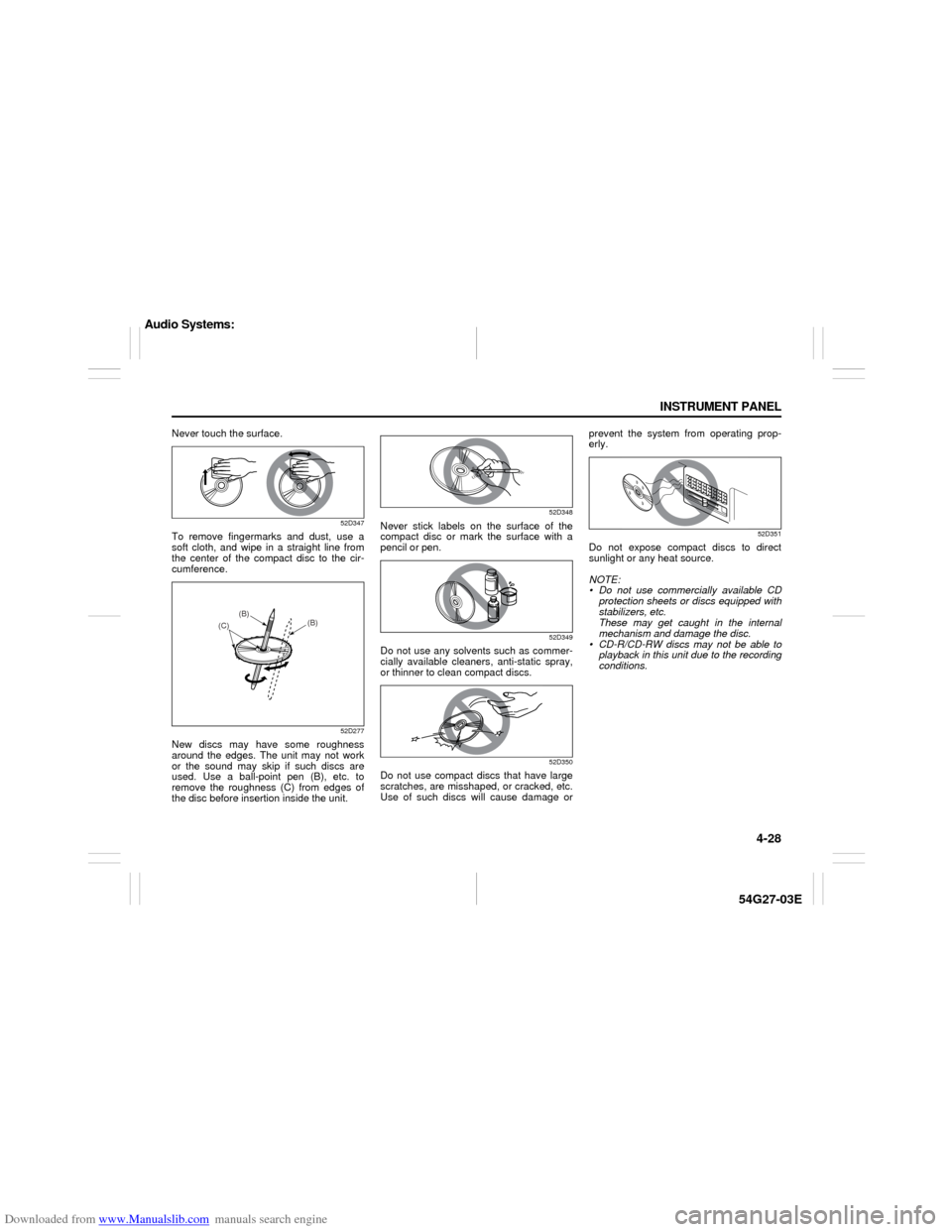
Downloaded from www.Manualslib.com manuals search engine 4-28 INSTRUMENT PANEL
54G27-03E
Never touch the surface.
52D347
To remove fingermarks and dust, use a
soft cloth, and wipe in a straight line from
the center of the compact disc to the cir-
cumference.
52D277
New discs may have some roughness
around the edges. The unit may not work
or the sound may skip if such discs are
used. Use a ball-point pen (B), etc. to
remove the roughness (C) from edges of
the disc before insertion inside the unit.
52D348
Never stick labels on the surface of the
compact disc or mark the surface with a
pencil or pen.
52D349
Do not use any solvents such as commer-
cially available cleaners, anti-static spray,
or thinner to clean compact discs.
52D350
Do not use compact discs that have large
scratches, are misshaped, or cracked, etc.
Use of such discs will cause damage orprevent the system from operating prop-
erly.
52D351
Do not expose compact discs to direct
sunlight or any heat source.
NOTE:
Do not use commercially available CD
protection sheets or discs equipped with
stabilizers, etc.
These may get caught in the internal
mechanism and damage the disc.
CD-R/CD-RW discs may not be able to
playback in this unit due to the recording
conditions.
(B)
(B)
(C)
Audio Systems:
Page 94 of 232
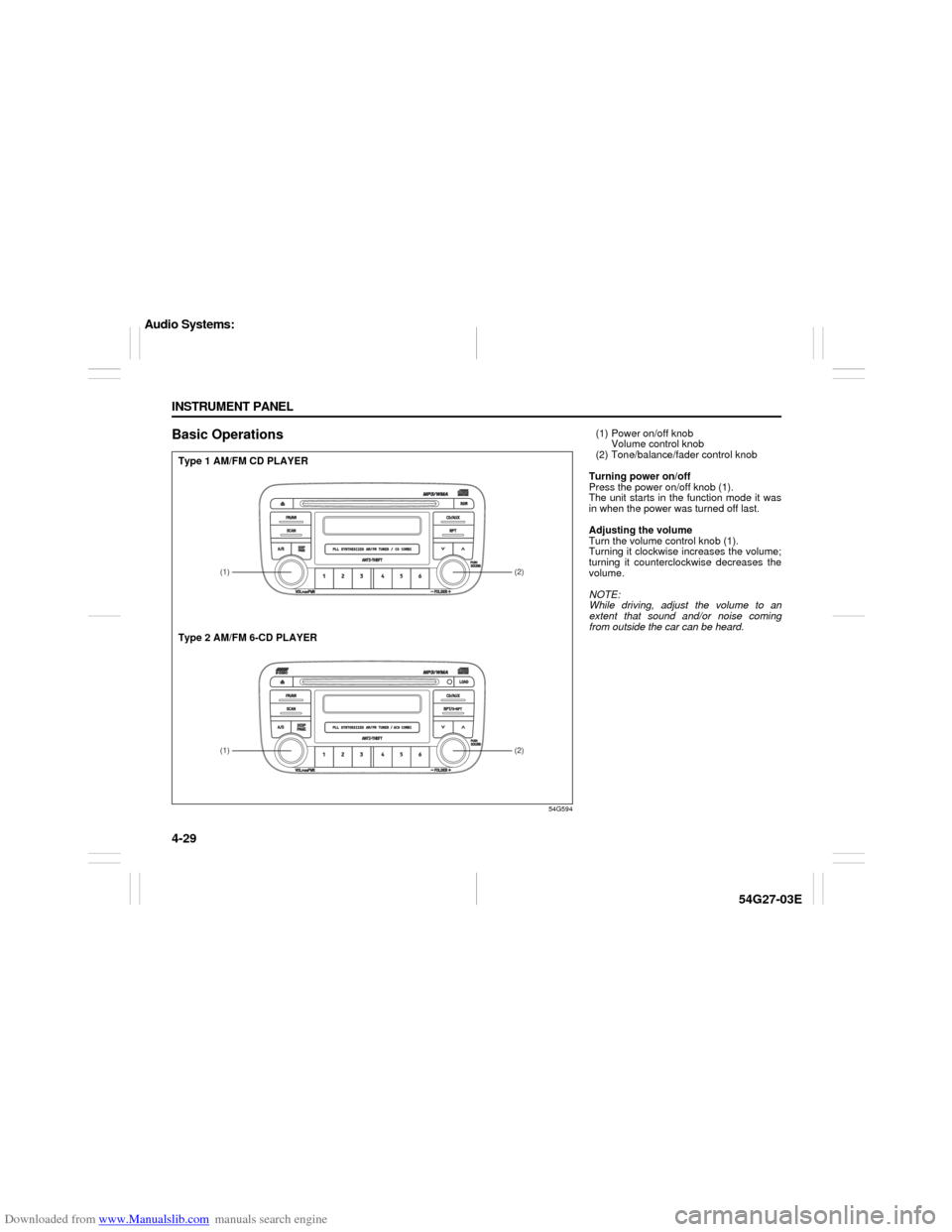
Downloaded from www.Manualslib.com manuals search engine 4-29 INSTRUMENT PANEL
54G27-03E
Basic Operations
54G594
(1)
(2)(2)
(1)
Type 1 AM/FM CD PLAYER
Type 2 AM/FM 6-CD PLAYER
(1) Power on/off knob
Volume control knob
(2) Tone/balance/fader control knob
Turning power on/off
Press the power on/off knob (1).
The unit starts in the function mode it was
in when the power was turned off last.
Adjusting the volume
Turn the volume control knob (1).
Turning it clockwise increases the volume;
turning it counterclockwise decreases the
volume.
NOTE:
While driving, adjust the volume to an
extent that sound and/or noise coming
from outside the car can be heard.
Audio Systems:
Page 95 of 232
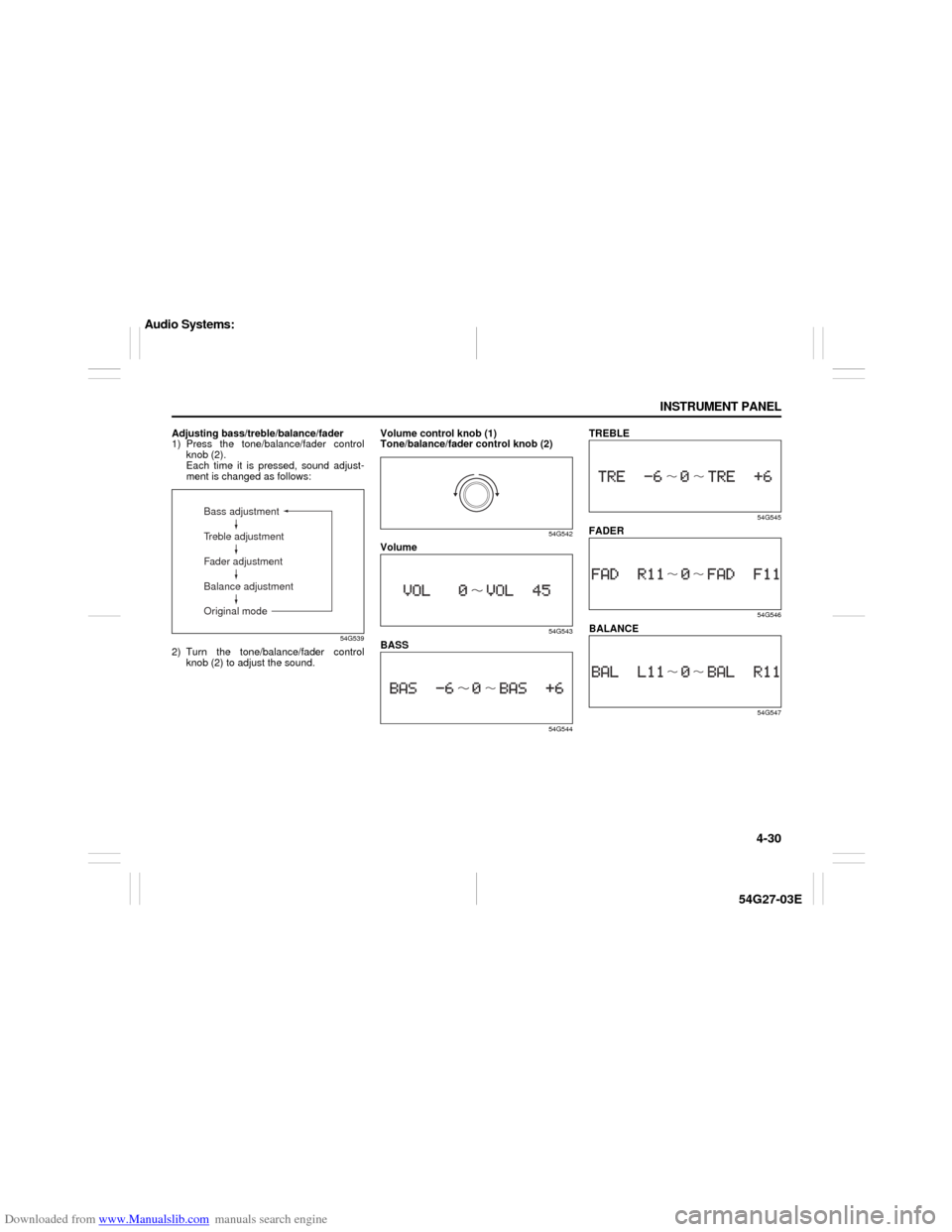
Downloaded from www.Manualslib.com manuals search engine 4-30 INSTRUMENT PANEL
54G27-03E
Adjusting bass/treble/balance/fader
1) Press the tone/balance/fader control
knob (2).
Each time it is pressed, sound adjust-
ment is changed as follows:
54G539
2) Turn the tone/balance/fader control
knob (2) to adjust the sound.Volume control knob (1)
Tone/balance/fader control knob (2)
54G542
Volume
54G543
BASS
54G544
TREBLE
54G545
FADER
54G546
BALANCE
54G547
Bass adjustment
Treble adjustment
Fader adjustment
Balance adjustment
Original mode
Audio Systems:
Page 96 of 232
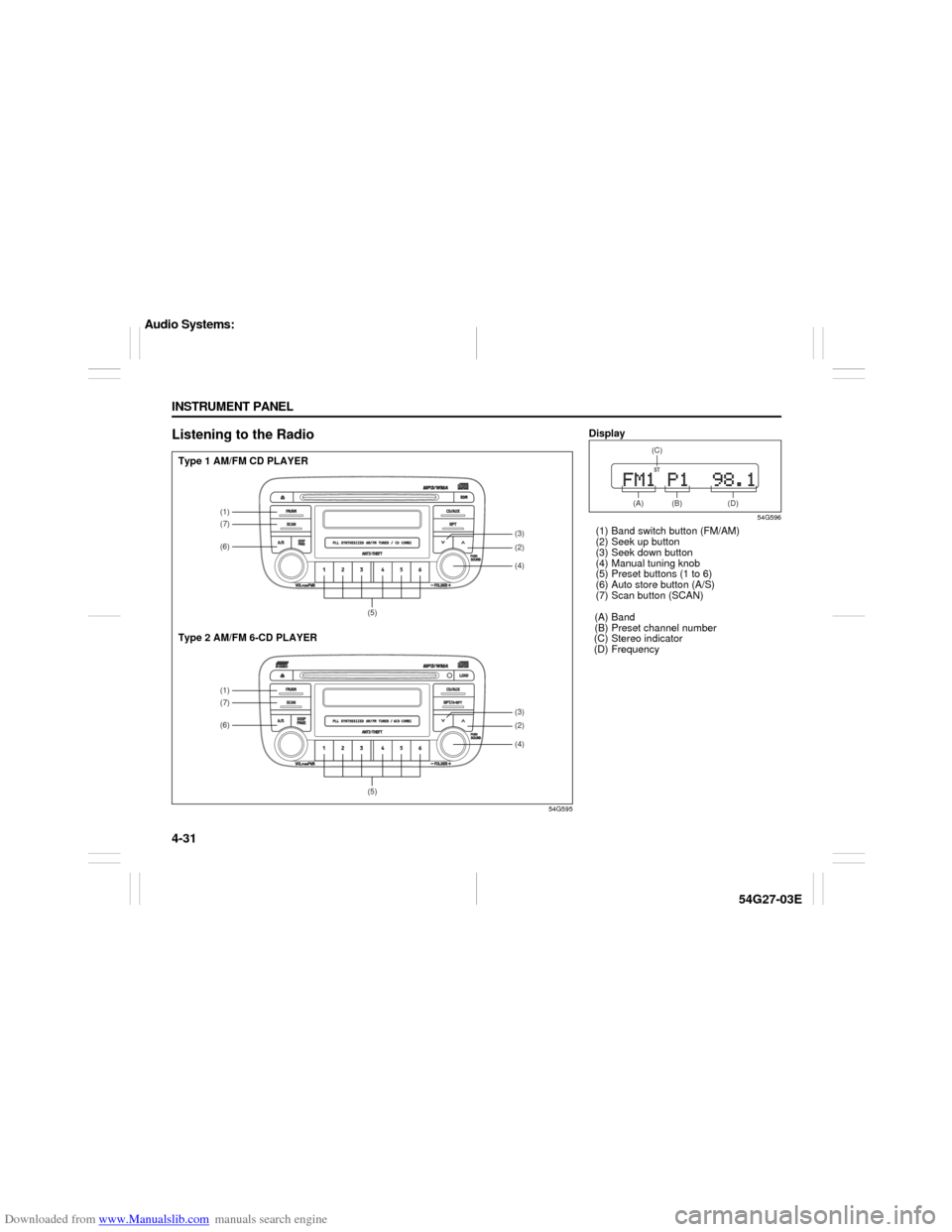
Downloaded from www.Manualslib.com manuals search engine 4-31 INSTRUMENT PANEL
54G27-03E
Listening to the Radio
54G595
(1)(7)(6)
(5)(1)(7)(6)
(5)
(4)(2)(3)(4)(2)(3)
Type 1 AM/FM CD PLAYER
Type 2 AM/FM 6-CD PLAYER
Display
54G596
(1) Band switch button (FM/AM)
(2) Seek up button
(3) Seek down button
(4) Manual tuning knob
(5) Preset buttons (1 to 6)
(6) Auto store button (A/S)
(7) Scan button (SCAN)
(A) Band
(B) Preset channel number
(C) Stereo indicator
(D) Frequency
(A) (B) (D)(C)
Audio Systems:
Page 97 of 232

Downloaded from www.Manualslib.com manuals search engine 4-32 INSTRUMENT PANEL
54G27-03E
Selecting the reception band
Press the band switch button (1).
Each time the button is pressed, the recep-
tion band is switched as follows:
54G550
Seek tuning
Press the seek up button (2) or the seek
down button (3).
The unit stops searching for a station at a
frequency where a broadcast station is
available.
Manual tuning
Turn the manual tuning knob (4).
The frequency being received is displayed.
Preset memory
1) Select the desired station.
2) Select the preset button (5) to which
you want to store the station and press
and hold the button for 2 seconds or
longer.
Auto store
1) Press the band switch button (1) and
select the band (FM2 or AM2).
2) Press the auto store button (6).Six stations in total are automatically
stored to the preset buttons (5) in sequen-
tial order, starting from the lower frequen-
cies.
NOTE:
When the auto store is performed, the
station previously stored in the memory
at the position is overwritten.
When there are fewer than 6 stations
that can be stored even if 2 rounds of
auto store operation are performed, the
stations previously stored at the remain-
ing preset buttons (5) are not overwrit-
ten.
Scan tuning
1) Press the scan button (7).
Stations are automatically sought for in
a sequential order, starting from a sta-
tion being currently received, and scan
stops for 5 seconds at a frequency
where there is a station available.
2) Press the scan button (7) again to stop
scanning at the frequency being cur-
rently received.
Receiving a stereo broadcast station
If a stereo broadcast station is received,
the stereo indicator (C) will light.
Radio Reception Radio reception can be affected by envi-
ronment, atmospheric conditions, or
radio signal’s power and distance from
the station. Nearby mountains and build-
ings may interfere or deflect radio recep-
tion, causing poor reception. Poor
reception or radio static can also be
caused by electric current from over-
head wires or high voltage power lines.
When listening to a radio while using a
cell phone or walkie-talkie in or close to
your vehicle, the radio may experience
noise interference.
Audio Systems:
Page 98 of 232
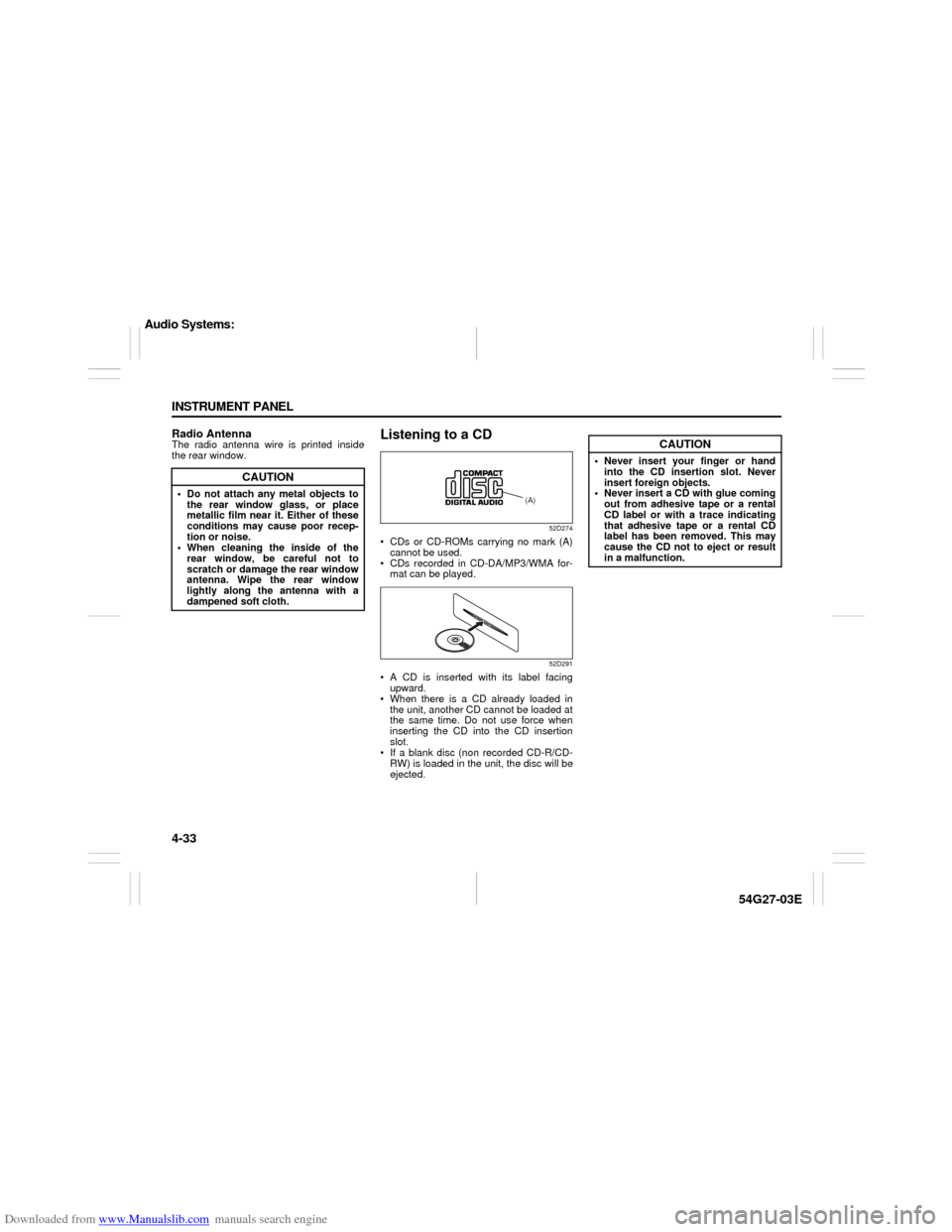
Downloaded from www.Manualslib.com manuals search engine 4-33 INSTRUMENT PANEL
54G27-03E
Radio AntennaThe radio antenna wire is printed inside
the rear window.
Listening to a CD
52D274
CDs or CD-ROMs carrying no mark (A)
cannot be used.
CDs recorded in CD-DA/MP3/WMA for-
mat can be played.
52D291
A CD is inserted with its label facing
upward.
When there is a CD already loaded in
the unit, another CD cannot be loaded at
the same time. Do not use force when
inserting the CD into the CD insertion
slot.
If a blank disc (non recorded CD-R/CD-
RW) is loaded in the unit, the disc will be
ejected.
CAUTION
Do not attach any metal objects to
the rear window glass, or place
metallic film near it. Either of these
conditions may cause poor recep-
tion or noise.
When cleaning the inside of the
rear window, be careful not to
scratch or damage the rear window
antenna. Wipe the rear window
lightly along the antenna with a
dampened soft cloth.
(A)
CAUTION
Never insert your finger or hand
into the CD insertion slot. Never
insert foreign objects.
Never insert a CD with glue coming
out from adhesive tape or a rental
CD label or with a trace indicating
that adhesive tape or a rental CD
label has been removed. This may
cause the CD not to eject or result
in a malfunction.
Audio Systems:
Page 99 of 232
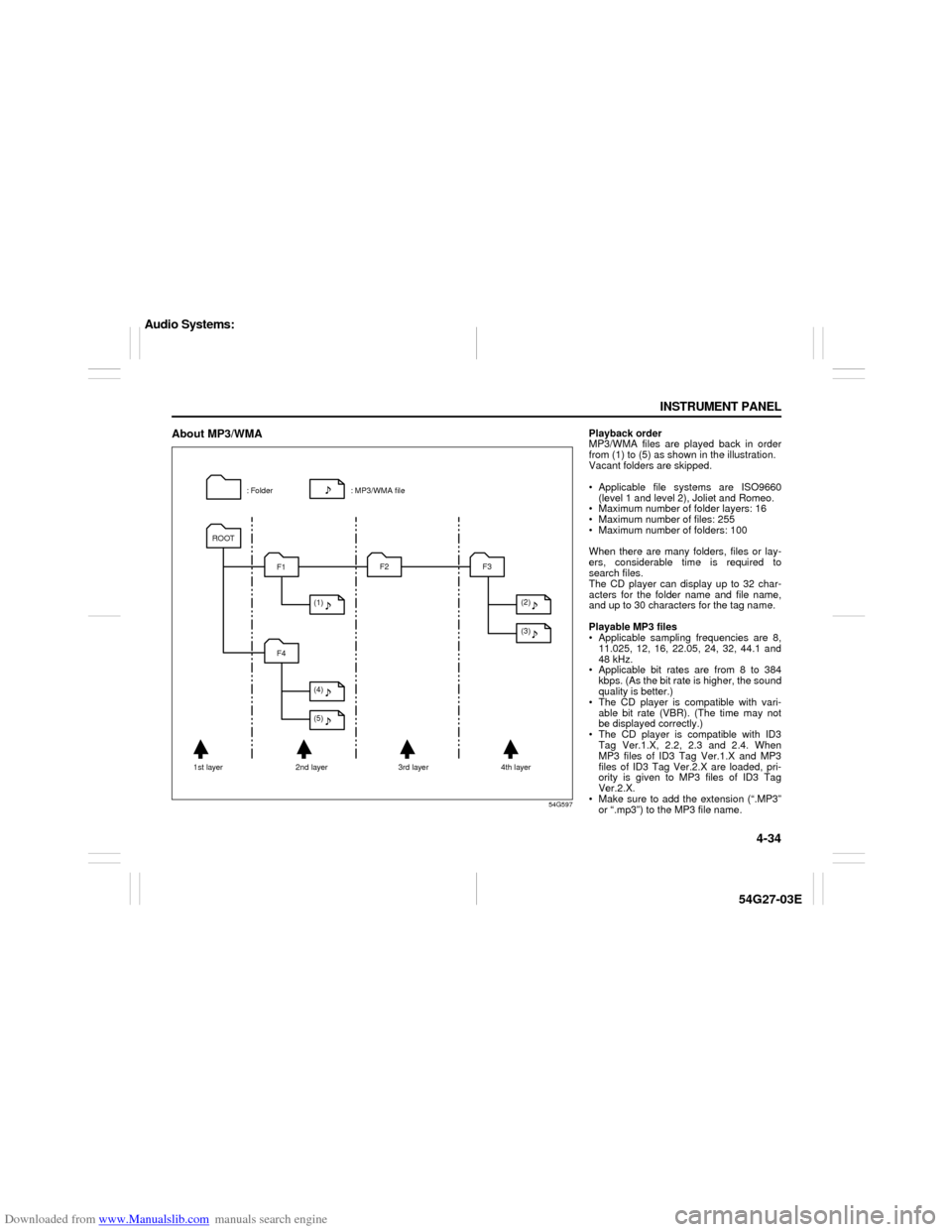
Downloaded from www.Manualslib.com manuals search engine 4-34 INSTRUMENT PANEL
54G27-03E
About MP3/WMA
54G597
: MP3/WMA file : Folder
1st layer 2nd layer 3rd layer 4th layerROOT
F1
F4F2 F3
(1)
(4)
(5)(2)
(3)
Playback order
MP3/WMA files are played back in order
from (1) to (5) as shown in the illustration.
Vacant folders are skipped.
Applicable file systems are ISO9660
(level 1 and level 2), Joliet and Romeo.
Maximum number of folder layers: 16
Maximum number of files: 255
Maximum number of folders: 100
When there are many folders, files or lay-
ers, considerable time is required to
search files.
The CD player can display up to 32 char-
acters for the folder name and file name,
and up to 30 characters for the tag name.
Playable MP3 files
Applicable sampling frequencies are 8,
11.025, 12, 16, 22.05, 24, 32, 44.1 and
48 kHz.
Applicable bit rates are from 8 to 384
kbps. (As the bit rate is higher, the sound
quality is better.)
The CD player is compatible with vari-
able bit rate (VBR). (The time may not
be displayed correctly.)
The CD player is compatible with ID3
Tag Ver.1.X, 2.2, 2.3 and 2.4. When
MP3 files of ID3 Tag Ver.1.X and MP3
files of ID3 Tag Ver.2.X are loaded, pri-
ority is given to MP3 files of ID3 Tag
Ver.2.X.
Make sure to add the extension (“.MP3”
or “.mp3”) to the MP3 file name.
Audio Systems:
Page 100 of 232

Downloaded from www.Manualslib.com manuals search engine 4-35 INSTRUMENT PANEL
54G27-03E
Playable WMA files
Applicable sampling frequencies are 32,
44.1 and 48 kHz.
Applicable bit rates are from 32 to 320
kbps. (As the bit rate is higher, the sound
quality is better.)
The CD player is compatible with vari-
able bit rate (VBR). (The time may not
be displayed correctly.)
The CD player is compatible with tags
specified by the Advanced Systems For-
mat (ASF) Specification.
Make sure to add the extension (“.WMA”
or “.wma”) to the WMA file name.
Explanation of terms
MP3
This is the abbreviation of “MPEG Audio
Layer 3”, and indicates a sound compres-
sion method.
This method can compress sound data
into approximately 1/10 of the original
quantity, and offers high quality sound.
WMA
This is the abbreviation of “Windows Media
Audio”, and indicates a sound compres-
sion method developed by Microsoft. This
method can create and store music files in
which sound data is compressed at a rate
higher than that of MP3.ID3 Tag
This identifies the data including the track
name, artist name and album name
recorded in an MP3 file.
VBR
This is the abbreviation of “Variable Bit
Rate”, and indicates a method which can
change the bit rate in accordance with the
data quantity.
ISO9660
This is the standard describing the logical
format for CD-ROMs specified by the Inter-
national Standardization Organization
(ISO).
Level 1:
The maximum number of characters in
folder names is 8 characters.
The file name consists of up to 8 charac-
ters plus an extension (3 characters).
Half-width capital alphabets, half-width
numeric characters and “_ (underscore)”
can be used.
Level 2:
The maximum number of characters in
folder names is 31 characters.
The file name consists of up to 27 charac-
ters plus an extension (3 characters).
Half-width capital alphabets, half-width
numeric characters and “_ (underscore)”
can be used.Joliet
This is a proposed logical format for CD-
ROMs by Microsoft, and maximum number
of characters is 64 characters.
Romeo
This is a proposed logical format for CD-
ROMs, and maximum number of charac-
ters is 128 characters.
Audio Systems: